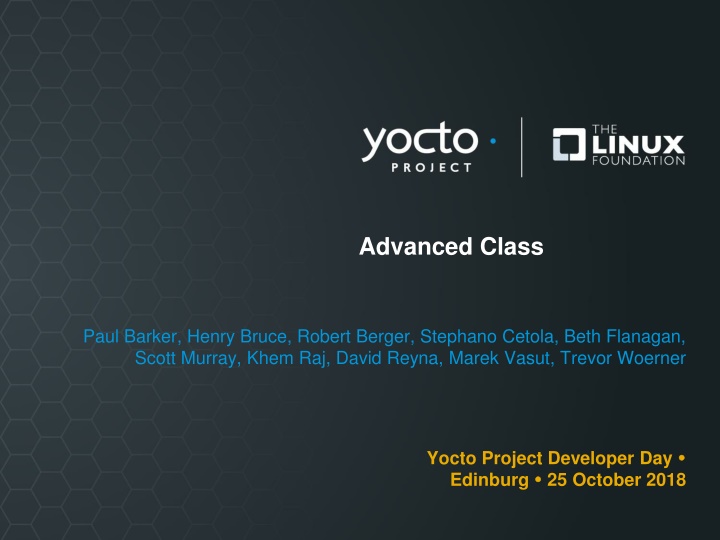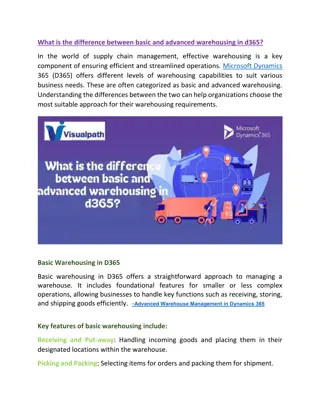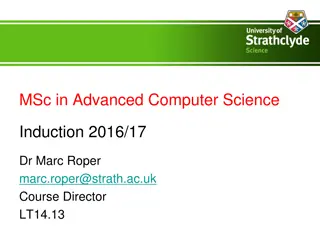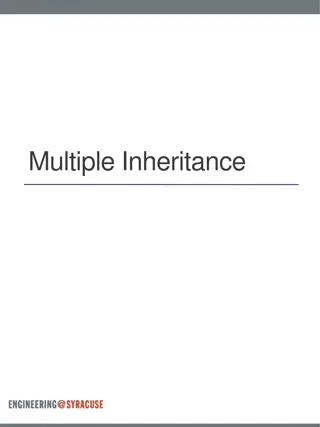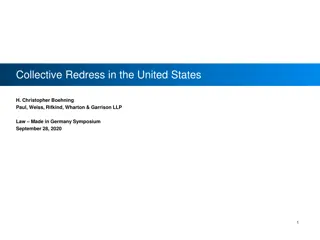Advanced Class
The content provides information and resources for the Yocto Project Developer Day Advanced Class, including the agenda, class setup, lab setup, and details on project preparation. It covers topics such as Package Feeds, U-Boot Bootloader, Licensing, Device Trees, Image Size Reduction, and more. The instructions for setting up the project and building it using bitbake are also included.
Download Presentation

Please find below an Image/Link to download the presentation.
The content on the website is provided AS IS for your information and personal use only. It may not be sold, licensed, or shared on other websites without obtaining consent from the author.If you encounter any issues during the download, it is possible that the publisher has removed the file from their server.
You are allowed to download the files provided on this website for personal or commercial use, subject to the condition that they are used lawfully. All files are the property of their respective owners.
The content on the website is provided AS IS for your information and personal use only. It may not be sold, licensed, or shared on other websites without obtaining consent from the author.
E N D
Presentation Transcript
Advanced Class Paul Barker, Henry Bruce, Robert Berger, Stephano Cetola, Beth Flanagan, Scott Murray, Khem Raj, David Reyna, Marek Vasut, Trevor Woerner Yocto Project Developer Day Edinburg 25 October 2018
Advanced Class Class Content (download these slides!): https://wiki.yoctoproject.org/wiki/DevDay_Edinburgh_2018 Requirements: Wireless connection: same as ELCE conference SSH (Windows: e.g. putty ) Wireless Registration: Will be passed out 2
Agenda The Advanced Class 9:00- 9:15 9:15- 9:45 9:45-10:15 10:15-10:30 10:30-11:15 11:15-12:00 12:00-12:45 12:45- 1:45 1:45- 2:15 2:30- 2:45 2:45- 3:15 3:15- 3:45 3:45- 4:15 4:15- 5:00 5:00- 5:30 Keynote Package Feeds Slim Bootloader Morning Break U-Boot Bootloader Devtool, Next steps Lunch Licensing 2.0 Device Trees 2.0 Afternoon Break Image Size Reduction (Fun with) Libraries/SDK and OE/YP Yocto Project - Rarely asked questions Tools, Toaster, User Experience Forum, Q and A 3
Yocto Project Dev Day Lab Setup The virtual host s resources can be found here: Your Project: "/scratch/poky/build-qemuarm Extensible-SDK Install: "/scratch/sdk/qemuarm Sources: "/scratch/src Poky: "/scratch/poky" Downloads: "/scratch/downloads" Sstate-cache: "/scratch/sstate-cache You will be using SSH to communicate with your virtual server. 5
FYI: How class project was prepared (1/2) $ $ cd /scratch $ git clone -b sumo git://git.yoctoproject.org/poky.git $ cd poky $ $ bash # set up local shell $ # Prepare the project $ ./scratch/poky/oe-init-build-env build $ echo "MACHINE = \"qemuarm\"" >> conf/local.conf $ echo "SSTATE_DIR = \"/scratch/sstate-cache\"" >> conf/local.conf $ echo "DL_DIR = \"/scratch/downloads\"" >> conf/local.conf $ echo "IMAGE_INSTALL_append = \" gdbserver openssh libstdc++ \ curl \"" >> conf/local.conf $ $ # Build the project $ bitbake core-image-base $ 6
FYI: How class project was prepared (2/2) $ # Build the eSDK $ $ bitbake core-image-base -c populate_sdk_ext $ cd /scratch/poky/build/tmp/deploy/sdk/ $ ./poky-glibc-x86_64-core-image-base-armv5e-toolchain-ext-*.sh \ -y -d /scratch/sdk/qemuarm $ exit # return to clean shell $ $ $ bash # set up local shell $ cd /scratch/sdk/qemuarm $ . /scratch/sdk/qemuarm/environment-setup-armv5e-poky-linux-gnueabi $ devtool modify virtual/kernel $ exit # return to clean shell $ 7
NOTE: Clean Shells! We are going to do a lot of different exercises in different build projects, each with their own environments. To keep things sane, you should have a new clean shell for each exercise. There are two simple ways to do it: 1. Close your existing SSH connection and open a new one -- or 2. Do a bash before each exercise to get a new sub-shell, and exit at the end to remove it, in order to return to a pristine state. 8
Activity One Keynote Nicolas Dechesne
Activity Two On Target Development using Package Feeds Stephano Cetola
Package Feed Overview Tested package types: rpm and ipk For rpm packages, we now use DNF instead of smart Setting up a package feed is EASY stephano.cetola@linux.intel.com @stephano approves this message Signing your packages and package feed is doable Two major use cases: On target development (faster and smarter) In the field updates (YMMV) 11
On Target Development Better, Faster, Stronger Topics Setting up a package feed On target example AWS + Beaglebone Black Signing package feeds Keeping your code secure The future of package feeds 12
Setting up a package feed - Target Setup Install Package Management on the target EXTRA_IMAGE_FEATURES += " package-management " Set the correct package class PACKAGE_CLASSES = "package_rpm Customize the feed (optional) PACKAGE_FEED_URIS = http://my-server.com/repo PACKAGE_FEED_BASE_PATHS = "rpm PACKAGE_FEED_ARCHS = all armv7at2hf-neon beaglebone" Edit /etc/yum.repos.d/oe-remote-repo.repo (optional) enabled=1 metadata_expire=0 gpgcheck=0 13
Setting up a package feed Publish a repo, index the repo, and $ bitbake core-image-minimal ... $ bitbake package-index ... $ twistd -n web --path tmp/deploy/rpm -p 5678 [-] Log opened [-] twistd 16.0.0 (/usr/bin/python 2.7.12) starting up. [-] reactor class: twisted.internet.epollreactor.EPollReactor. [-] Site starting on 5678 You are now running a web server on port 5678 14
On Target Development Better, Faster, Stronger Topics Setting up a package feed On target example AWS + Beaglebone Black Signing package feeds Keeping your code secure The future of package feeds 15
Caveats Running bitbake world can take some time You may want to update your repo as needed Serve the repo from a build machine Or simply rsync to a webserver Do not forget to run `bitbake packge-index` Package index will not auto-update Good practice is to dogfood your repo 16
Understanding RPM Packages and repomd.xml repomd == Repo Metadata This is the package index Repository Tools createrepo rpm2cpio dnf (replaces yum) yum-utils (historical) Important Commands rpm -qip (general info) rpm -qpR (depends) https://wiki.yoctoproject.org/wiki/TipsAndTricks/UsingRPM 17
Package Feeds: On Target Demo Beaglebone Repo on AWS
On Target Development Better, Faster, Stronger Topics Setting up a package feed On target example AWS + Beaglebone Black Signing package feeds Keeping your code secure The future of package feeds 19
Signing The Packages Inherit bbclass to enable signing functionality INHERIT += sign_rpm Define the GPG key that will be used for signing. RPM_GPG_NAME = "key_name Provide passphrase for the key RPM_GPG_PASSPHRASE = "passphrase" 20
Signing The Package Feed Inherit bbclass to enable signing functionality INHERIT += sign_package_feed Define the GPG key that will be used for signing. PACKAGE_FEED_GPG_NAME = "key_name Provide passphrase for the key PACKAGE_FEED_GPG_PASSPHRASE_FILE = "passphrase" 21
Signing The Package Feed (optional) GPG_BIN GPG binary executed when the package is signed GPG_PATH GPG home directory used when the package is signed. PACKAGE_FEED_GPG_SIGNATURE_TYPE Specifies the type of gpg signature. This variable applies only to RPM and IPK package feeds. Allowable values for the PACKAGE_FEED_GPG_SIGNATURE_TYPE are "ASC", which is the default and specifies ascii armored, and "BIN", which specifies binary. 22
Testing Packages with ptest (Optional? Not really!) Package Test (ptest) Runs tests against packages Contains at least two items: 1 the actual test (can be a script or an elaborate system) 2 shell script (run-ptest) that starts the test (not the actual test) Simple Setup DISTRO_FEATURES_append = " ptest EXTRA_IMAGE_FEATURES += "ptest-pkgs Installed to: /usr/lib/package/ptest 23
On Target Development Better, Faster, Stronger Topics Setting up a package feed On target example AWS + Beaglebone Black Signing package feeds Keeping your code secure The future of package feeds 24
Keeping feeds secure PACKAGE_FEED_GPG_PASSPHRASE_FILE This should NOT go in your configuration as plain text. Is your code proprietary? You should probably be shipping a binary in Yocto bin_package.bbclass: binary can be .rpm, .deb, .ipk Have you thought about DEBUG_FLAGS? See bitbake.conf for more details The flags can be filtered or set in the recipe 25
On Target Development Better, Faster, Stronger Topics Setting up a package feed On target example AWS + Beaglebone Black Signing package feeds Keeping your code secure The future of package feeds 26
The Future of Package Feeds Can We Upgrade? Repository Switch to new source entries Remove unknown (3rd party) repositories Package Check there are no broken or renamed packages Versioning: what happens when they go backwards Remove and install specific packages (release dependent) Remove blacklisted / obsolete and add whitelisted Dreaming Even Bigger Kernels, Desktops (UI), Permissions, Users, Groups 27
Activity Three Slim Bootloader Stephano Cetola
Slim Bootloader Slides are available at: https://wiki.yoctoproject.org/wiki/File:Developing_Boot_Soluti ons_for_Intel_IoT_Unique_Use_Cases_rev1a.pptx Master DevDay Slides Page: https://wiki.yoctoproject.org/wiki/DevDay_Edinburgh_2018 29
Activity Four U-Boot bootloader Marek Vasut
Booting contemporary hardware Contemporary embedded system boots like this Power on (optional) BootROM (optional) First stage bootloader Next stage bootloader (optional) other bootloader stages Linux kernel Userspace We will focus on the bootloader parts 31
U-Boot bootloader De-facto standard bootloader in embedded Capable of starting Linux, *BSD, RTOSes, UEFI apps U-Boot is also a boot monitor U-Boot has a powerful command shell Allows manipulating with the boot process (boot different kernel, script the boot process...) U-Boot is also a debug multitool U-Boot shell tools allow operating hardware blocks (memory IO, SPI, I2C, network, USB, ...) 32
Experimenting with U-Boot bootloader Three ways of doing that: U-Boot sandbox target U-Boot built as a Linux userspace binary QEMU U-Boot running in QEMU Real hardware (danger zone) U-Boot running on real HW Flashing incorrect bootloader brick the device :-) 33
Experimenting with U-Boot bootloader in OE Use the meta-dto-microdemo layer Metalayer contains convenience recipes The u-boot-sandbox recipe To quickly build U-Boot sandbox native target See recipes-bsp/u-boot/ Kernel config changes to enable virt platform See recipes-kernel/linux/files/force-virt.cfg DTO related things for later 34
DTO Hands-on 1/2 Experimenting with U-Boot bootloader in OE Add meta-dto-demo to bblayers.conf BBLAYERS: $ echo "BBLAYERS += \"/scratch/src/dto/meta-dto-microdemo\"" \ >> conf/bb_layers.conf $ echo "MACHINE = \"qemuarm\"" >> conf/local.conf $ echo "SSTATE_DIR = \"/scratch/sstate-cache\"" >> conf/local.conf $ echo "DL_DIR = \"/scratch/downloads\"" >> conf/local.conf $ echo "UBOOT_MACHINE = \"qemu_arm_defconfig\"" >> conf/local.conf Rebuild u-boot, u-boot-sandbox-native and qemu-native $ bitbake -c cleansstate u-boot u-boot-sandbox-native qemu-native \ $ bitbake u-boot u-boot-sandbox-native u-boot-mkimage-native \ virtual/kernel qemu-native virtual/kernel 35
DTO Hands-on 1/2 Experimenting with U-Boot bootloader in OE Start the u-boot sandbox (use Ctrl-C to exit) $ ./tmp/work/x86_64-linux/u-boot-sandbox-native/\ 1_2018.01-r0/git/u-boot U-Boot 2018.01-dirty (Oct 14 2018 - 11:30:36 +0000) [ ] SCSI: Net: No ethernet found. IDE: Bus 0: not available Hit any key to stop autoboot: 0 => => help ? - alias for 'help' base - print or set address offset bootz - boot Linux zImage image from memory [ ] => help bootz bootz - boot Linux zImage image from memory Usage: bootz [addr [initrd[:size]] [fdt]] - boot Linux zImage stored in memory The argument 'initrd' is optional and specifies the address 36
DTO Hands-on 1/2 Experimenting with U-Boot bootloader in OE Start U-Boot in QEMU $ ./tmp/work/x86_64-linux/qemu-native/\ 2.11.1-r0/build/arm-softmmu/qemu-system-arm \ -machine virt \ -bios tmp/deploy/images/qemuarm/u-boot.bin -nographic U-Boot 2018.01 (Oct 11 2018 - 13:14:21 +0000) DRAM: 128 MiB WARNING: Caches not enabled Using default environment In: pl011@9000000 Out: pl011@9000000 Err: pl011@9000000 Net: No ethernet found. Hit any key to stop autoboot: 0 => (CTRL-A x to quit QEMU) 37
DTO Hands-on 1/2 Booting the kernel zImage Generate suitable NOR flash image $ dd if=/dev/zero of=/tmp/test.bin bs=16M count=0 seek=1 $ dd if=tmp/deploy/images/qemuarm/u-boot.bin \ of=/tmp/test.bin conv=notrunc $ dd if=tmp/deploy/images/qemuarm/zImage \ of=/tmp/test.bin bs=1M seek=1 conv=notrunc Start U-Boot with this NOR flash image $ ./tmp/work/x86_64-linux/qemu-native/2.11.1-r0/\ build/arm-softmmu/qemu-system-arm \ -machine virt -bios /tmp/test.bin -nographic U-Boot 2018.01 (Oct 11 2018 - 13:14:21 +0000) DRAM: 128 MiB In: pl011@9000000 Out: pl011@9000000 Err: pl011@9000000 Net: No ethernet found. Hit any key to stop autoboot: 0 => 38
DTO Hands-on 1/2 Booting the kernel zImage Figure out where the RAM is => bdi arch_number = 0x00000000 boot_params = 0x00000000 DRAM bank = 0x00000000 -> start = 0x40000000 -> size = 0x08000000 baudrate = 115200 bps TLB addr = 0x47FF0000 relocaddr = 0x47F88000 reloc off = 0x47F88000 irq_sp = 0x46F66ED0 sp start = 0x46F66EC0 Early malloc usage: 104 / 400 fdt_blob = 46f66ee8 Kernel is ~ 8 MiB, copy it to RAM start + 0x8000 => cp 0x100000 0x40008000 0x200000 39
DTO Hands-on 1/2 Booting the kernel zImage Boot the zImage with DT => bootz 0x40008000 - $fdtcontroladdr Kernel image @ 0x40008000 [ 0x000000 - 0x524da0 ] ## Flattened Device Tree blob at 46f66ee8 Booting using the fdt blob at 0x46f66ee8 Using Device Tree in place at 46f66ee8, end 46f79ee7 Starting kernel ... [ 0.000000] Booting Linux on physical CPU 0x0 [ 0.000000] Linux version 4.14.67-yocto-standard (oe-user@oe-host) (gcc version 7.3.0 (GCC)) #1 PREEMPT Thu Oct 11 13:10:58 UTC 2018 [ 0.000000] CPU: ARMv7 Processor [412fc0f1] revision 1 (ARMv7), cr=10c53c7d [ 0.000000] CPU: div instructions available: patching division code [ 0.000000] CPU: PIPT / VIPT nonaliasing data cache, PIPT instruction cache [ 0.000000] OF: fdt: Machine model: linux,dummy-virt [ 0.000000] Memory policy: Data cache writeback [ 0.000000] psci: probing for conduit method from DT. [ 0.000000] psci: PSCIv0.2 detected in firmware. The $fdtcontroladdr is DT generated by QEMU You can dump the DT by appending -machine dumpdtb=file.dtb 40
Kernel image types zImage and Image zImage and Image Linux binary with decompressor No protection against bitrot Set up registers as needed and jump to it DT is optional and separate Boot with U-Boot bootz command On Aarch64, similar type of image is called Image Boot with booti command uImage fitImage 41
Kernel image types uImage zImage and Image uImage Envelope around arbitrary file Legacy since forever Small header with CRC32 and metadata Note that CRC32 is weak Metadata contain payload type, load address... Wraps only one single file Boot with bootm command fitImage 42
Kernel image types fitImage zImage and Image uImage FitImage Multi-component image Based on DT Can bundle multiple files with different properties Configurable checksum per-entry CRC32, MD5, SHA1, SHA256... Supports digital signatures RSA2048, RSA4096... 43
DTO Hands-on 1/2 Building the kernel fitImage QEMU specific step dump the DTB => $ qemu-system-arm -machine virt -nographic -machine dumpdtb=qemu.dtb Copy over the fitImage source from the metalayer $ cp /scratch/src/dto/meta-dto-microdemo/recipes-kernel/\ linux/files/fit-image.its . Build the fitImage: $ export PATH=$PATH:tmp/work/x86_64-linux/dtc-native/\ 1.4.5-r0/image/scratch/poky/build/tmp/work/x86_64-linux/\ dtc-native/1.4.5-r0/recipe-sysroot-native/usr/bin/ $ ./tmp/work/x86_64-linux/u-boot-mkimage-native/\ 1_2018.01-r0/git/tools/mkimage -f ./fit-image.its /tmp/fitImage FIT description: Linux kernel and FDT blob Created: Sun Oct 14 12:57:59 2018 Image 0 (kernel-1) Description: Linux kernel Created: Sun Oct 14 12:57:59 2018 Type: Kernel Image Compression: uncompressed Data Size: 5393824 Bytes = 5267.41 KiB = 5.14 MiB Architecture: ARM OS: Linux [ ] 44
DTO Hands-on 1/2 Booting the kernel fitImage Generate suitable NOR flash image $ dd if=/dev/zero of=/tmp/test.bin bs=16M count=0 seek=1 $ dd if=tmp/deploy/images/qemuarm/u-boot.bin \ of=/tmp/test.bin conv=notrunc $ dd if=/tmp/fitImage \ of=/tmp/test.bin bs=1M seek=1 conv=notrunc Start U-Boot with this NOR flash image $ ./tmp/work/x86_64-linux/qemu-native/2.11.1-r0/\ build/arm-softmmu/qemu-system-arm \ -machine virt -bios /tmp/test.bin -nographic [ ] => setenv fdt_high 0x48000000 => bootm 0x100000 ## Loading kernel from FIT Image at 00100000 ... Using 'conf-1' configuration Trying 'kernel-1' kernel subimage [ ] Loading Device Tree to 46f49000, end 46f5bfff ... OK Starting kernel ... 45
DTO Hands-on 1/2 fitImage source format $ cat fit-image.its /dts-v1/; / { description = "Linux kernel and FDT blob"; images { kernel-1 { description = "Linux kernel"; data = /incbin/("./tmp/deploy/images/qemuarm/zImage"); type = "kernel"; arch = "arm"; os = "linux"; compression = "none"; load = <0x40008000>; entry = <0x40008000>; hash-1 { algo = "crc32"; }; }; fdt-1 { description = "Flattened Device Tree blob"; data = /incbin/("./qemu.dtb"); type = "flat_dt"; arch = "arm"; compression = "none"; hash-1 { algo = "md5"; }; }; }; 46
DTO Hands-on 1/2 fitImage source format / { [ ] description = "Linux kernel and FDT blob"; images { Kernel-1 { }; Fdt-1 { }; }; ... ... configurations { default = "conf-1"; conf-1 { description = "Boot Linux kernel with FDT blob"; kernel = "kernel-1"; fdt = "fdt-1"; hash-1 { algo = "sha1"; }; }; }; }; 47
DTO Hands-on 1/2 Notes on fitImage It is possible to bundle multiple Kernel images, FDTs, firmwares, bitstreams Have multiple configurations The $fdt_high variable Sets the upper bound memory address for FDT relocation Special value 0xffffffff = -1 means do not relocate FDT Some platforms need FDT close to the kernel binary Information about uImage and fitImage, iminfo Extracting data from fitImage imxtract 48
DTO Hands-on 1/2 Notes on fitImage iminfo => iminfo 0x100000 ## Checking Image at 00100000 ... FIT image found FIT description: Linux kernel and FDT blob Image 0 (kernel-1) Description: Linux kernel Type: Kernel Image Compression: uncompressed Data Start: 0x001000ec Data Size: 5393824 Bytes = 5.1 MiB Architecture: ARM OS: Linux Load Address: 0x40008000 Entry Point: 0x40008000 Hash algo: crc32 Hash value: bf5547fe Image 1 (fdt-1) [...] Default Configuration: 'conf-1' Configuration 0 (conf-1) Description: Boot Linux kernel with FDT blob Kernel: kernel-1 FDT: fdt-1 ## Checking hash(es) for FIT Image at 00100000 ... Hash(es) for Image 0 (kernel-1): crc32+ 49
DTO Hands-on 1/2 Notes on fitImage configurations => iminfo 0x100000 ## Checking Image at 00100000 ... FIT image found FIT description: Linux kernel and FDT blob Image 0 (kernel-1) Description: Linux kernel Type: Kernel Image [...] Image 1 (fdt-1) [...] Default Configuration: 'conf-1' Configuration 0 (conf-1) => help bootm bootm - boot application image from memory Usage: bootm [addr [arg ...]] - boot application image stored in memory ... For the new multi component uImage format (FIT) addresses must be extended to include component or configuration unit name: addr:<subimg_uname> - direct component image specification addr#<conf_uname> - configuration specification Use iminfo command to get the list of existing component images and configurations. 50
